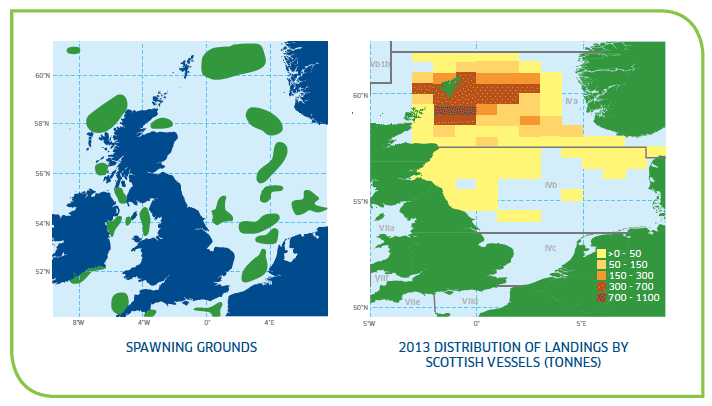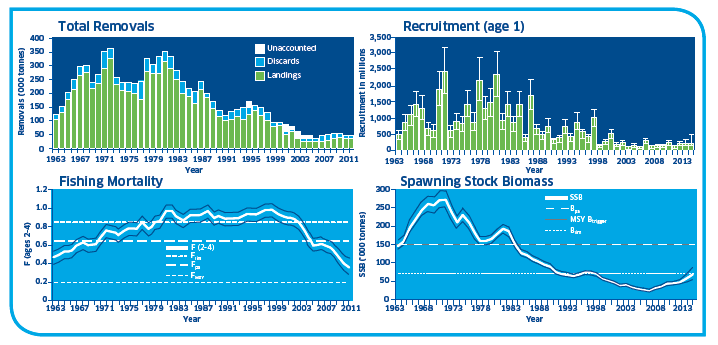Fish and Shellfish Stocks: 2015 Edition
Information on the state of fish and shellfish stocks of commercial importance to the Scottish fleet, inclduing Total Allowable Catches (TACs) for each stock.
Cod Stocks - North Sea (IIIa, IV and VIId)
Cod ( Gadus morhua), by weight, is the third most important demersal species landed from the North Sea by Scottish fishermen. Like many North Sea stocks, cod are overfished with a high percentage of removals from the stock unaccounted for.
2015 position: UK share of 11,369 tonnes
Last Year: 10,827 tonnes
Landed into Scotland in 2013: 10,653 tonnes
Value for 2013: £20.73 million
Biology
Cod occur mainly in the northern and central areas. New born cod are distributed over a large part of this area, with high concentrations off the Jutland coast. One and two year old cod tend to overwinter in shallow coastal areas, but eventually disperse into deeper water. Whilst some cod tend to reside all year around in coastal areas, the larger offshore congregations of cod tend to be migratory.
Many cod now reach maturity at two years old, with 50% mature by three years old. By the time they reach five years, all cod are mature.
An adult female of around 80 cm can produce around four million eggs in a season. Most spawning takes place between February and March with the largest spawning areas in the northern North Sea and around Dogger bank. Young cod live in the upper water layers for a period before moving to the seabed in July and August. They grow quickly and can reach 20cm after one year, 50cm after two years and 80cm by the time they are four years old. By the time they reach two years old, young cod are fully exploited by the commercial fishery as the minimum landing size for cod is 35cm. Many fish are caught long before they have the chance to spawn, and less than one twentieth of one year olds will survive to the age of four.
Cod do not usually browse for food on the bottom but are active feeders. By weight, around three quarters of the food of all sizes of cod consists of fish and crustaceans. The rest is made up of small quantities of molluscs and worms. As they grow, cod eat an increasing amount of fish. Sandeel, Norway pout, whiting, herring, dab and cod themselves are the main fish species eaten.

ICES Advice on Management
Information Source: ICES advice 2014
http://www.ices.dk/sites/pub/Publication%20Reports/Advice/2014/2014/cod-347d.pdf
Quoted text in italics.

MSY and precautionary approach reference points
| Type |
Value |
|
|---|---|---|
| Management Plan |
SSB MP |
150,000 t |
| F MP |
0.4 |
|
| MSY Approach |
M S Y Btrigger |
150,000 t |
| F MSY |
0.19 |
|
| Precautionary Approach |
Blim |
70,000 t |
| Bpa |
150,000 t |
|
| Flim |
0.86 |
|
| Fpa |
0.65 |
|
State of stock and advice
- Fishing mortality in 2013 was estimated to be 0.398: this means that approximately 32.8%, by number, of all fish between 2 and 4 years of age were caught.
- Spawning stock biomass has increased since its historical low in 2006, and is estimated to be just below Blim in 2014 at 68,528 tonnes.
- Fishing mortality and biomass are between and below, respectively, the precautionary approach limits. However fishing mortality is well above the level which is consistent with achieving maximum sustainable yield ( F2013> F MSY).
- The ICES advice is in accordance with the long-term management plan and recommends that landings in 2015 should be no more than 26,713 tonnes for areas IIa, IIIa Skagerrak, IV and VIId combined.
Scotland implemented in February 2008 a national scheme known as the "Conservation Credits Scheme". The principle of this two-part scheme involves additional time at sea in return for the adoption of measures which aim at reducing mortality on cod and leading to a reduction in discard numbers. One measure was real- time closures. In 2010, there were 165 closures, and from July 2010 the area of each closure increased (from 50 square nautical miles to 225 square nautical miles). During 2011 there were 185 of these larger closures, while there were 173 in 2012. ICES notes that from the initial year of operation (2008) cod discarding rates in Scotland have decreased from 62% in 2008 to 24% (in weights) in 2011 and 2012, but have increased again to 31% in 2013.
The introduction of closed-circuit TV ( CCTV, 20% of landings in 2013) and fully documented fisheries ( FDF) programmes starting in 2010 in Scotland, Denmark, Germany, the Netherlands, and England is expected to have contributed to the reduction of cod mortality. Under this scheme, UK vessels are not permitted to discard any cod, while Danish and German vessels are still permitted to discard undersized cod. For all vessels taking part, all cod caught are counted against the quota. Some of the fleets in this programme have shown a noticeable increase in smaller fish in the landings, which could imply that less highgrading occurs.
Management outcomes for 2015
In December 2014 the Council of Ministers decided that the EU Total Allowable Catch for cod in Subarea IV and Division IIa should be 24,227 tonnes. The UK quota for 2015 was set at 11,369 tonnes. This quota decision is consistent with the existing cod long term management plan ( LTMP). This plan (affecting a number of cod stocks) includes an effort management scheme that limits the effort available to the main cod catching gears. The Council Regulation covering the plan also includes provision for applying management measures to reduce cod mortality without reducing effort. The UK interpretation of permissible effort 'buy back' under the Conservation Credits Scheme (effort levels can be reinstated up to the level of the baseline established at the start of the scheme) was upheld. In accordance with the cod LTMP, a further 10% cut in effort (before buy back) from the baseline applied in 2014. To justify existing and future effort buy back the UK was committed to the introduction of highly selective gears and several gears were developed, tested and introduced.
Contact
There is a problem
Thanks for your feedback